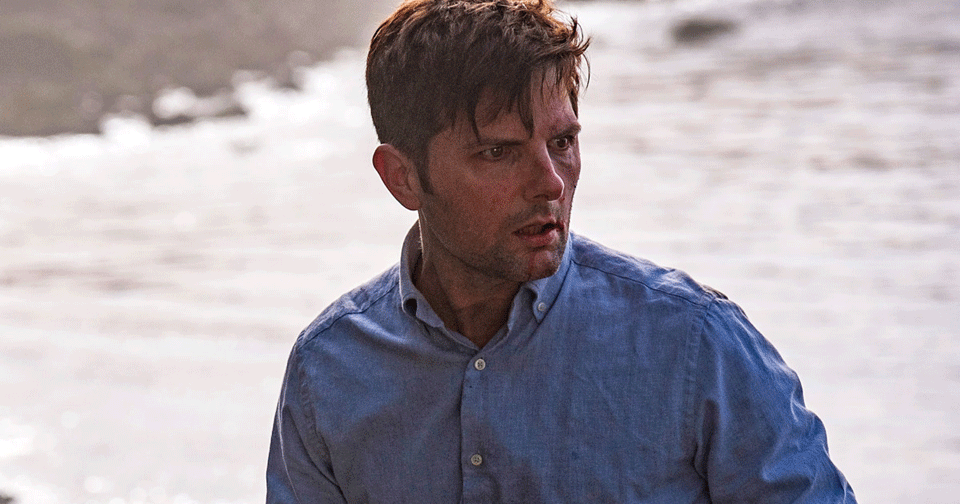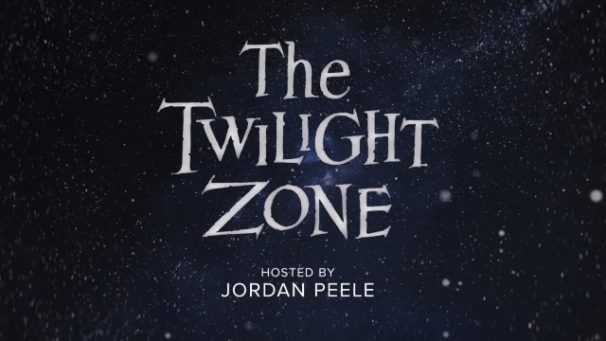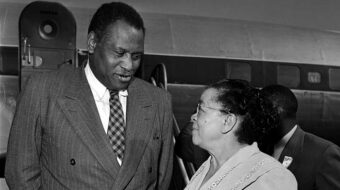
Editor’s note: A review and analysis of Jordan Peele’s “The Twilight Zone” episode two. Spoilers ahead.
“The flight path to Hell is paved with good intentions” – The Twilight Zone
Jordan Peele’s The Twilight Zone is currently being shown weekly on the streaming service CBS All Access. The second episode of the series, “Nightmare at 30,000 Feet,” is a play on the original Rod Serling’s Twilight Zone episode “Nightmare at 20,000 Feet” using similar themes, but ultimately telling a totally different story. “Nightmare at 30,000 Feet” focuses more on the role of journalists and the news media to expose the so-called unbiased truth and the ways in which that can go terribly wrong, leading to disastrous results.
The episode stars Adam Scott (Little Evil), Chris Diamantopoulos (The Truth About Lies), Katie Findlay (Jem and the Holograms) and China Shavers (Beginners). It is directed by Greg Yaitanes (Castle Rock) and written by Marco Ramirez (The Defenders). Scott plays Justin Sanderson, a journalist, suffering from PTSD caused by his time in Yemen. Justin is taking a flight to Tel Aviv for an assignment. While on the flight he finds an MP3 player that is playing a podcast called “Enigmatique.” As Justin listens to the podcast he realizes that it appears to be listing off certain details and events relating to the very flight he is on, and how it is set to disappear in less than an hour from take off. Justin finds himself on a race against time to figure out what caused the plane to crash, and prevent it before it actually does.
This second episode was stronger than the first in making the usual plot twist, that is to be expected in The Twilight Zone, less obvious in the beginning of the program. While most could guess the ending of “The Comedian” within fifteen minutes from the start, “Nightmare at 30,000 Feet” makes it harder to figure out the outcome for the protagonist. This makes it so the hour-long episode doesn’t feel like it drags as much as the previous episode did.
Scott does well in drawing the audience into Justin’s growing anxiety of impending doom, and his strong conviction to uncover the truth. There are little throwbacks to well-known original Twilight Zone episodes that longtime fans will enjoy. What this episode has going for it, is that it takes the well-known “Nightmare at 20,000 Feet,” that many are familiar with, and flips the theme of truth on its head to be more relevant to 2019.
“Nightmare at 20,000 Feet,” originally airing on October 11, 1963, and based on the short story Alone by Night by Richard Matheson, tells the story of Robert Wilson who believes there is a gremlin on the wing of the plane he is taking trying to sabotage the flight. Robert repeatedly tries to alert the flight crew, but no one believes him due to his past mental breakdown. In the end, after Robert causes the plane to make an emergency landing and is led away in a straitjacket, it is discovered that there was damage being caused to the plane by the gremlin, thus validating Richard standing in his truth. One could interpret the original being a commentary on paranoia and the stigma against those dealing with mental health issues. Peele’s “Nightmare at 30,000 Feet” touches upon the mental health aspect briefly, but as the episode progresses it’s clear that is not the focus of this retelling.
Peele has replaced the protagonist Robert Wilson, who was originally a salesperson, with Justin, who is a political journalist. This doesn’t seem coincidental, but deliberate, as the story goes on. Sanderson is a well-known journalist who has covered many events, such as the conflict in Yemen. He’s dealt with the trauma of those events, and through therapy has a motto of not allowing his past to determine his future. His latest article is called “The End of Civility.” Being an investigative journalist it is made clear that Sanderson has a hard time letting things go, and almost obsessively follows a story through until the end. This drive to keep the focus on a story, that may not need to ultimately be told, is clearly what leads to his demise.
Justin, in listening to the ominous podcast, follows clues and causes disturbances on the flight. As the episode goes on the viewer soon realizes it is Justin’s actions that are fueling the climate of hysteria on the flight. This differs from “Nightmare at 20,000 Feet,” as Robert was powerless in the face of the mysterious gremlin, and alone in his quest to thwart the actual monster. Justin is not powerless in the situation but shown to be the main cause of the events. Justin creates the “monster” of hysteria and empowers the character, Joe, a reader of Sanderson’s work, to enter the cockpit and purposefully crash the flight.
Justin stood in his truth, but without taking a look at himself, was unable to realize the fault in it. When the plane crashes, and somehow everyone survives, they turn on Justin, killing him in an act of aggression for believing he was the root cause of the crash. Even as Justin is getting ready to be stoned to death, he asserts that he was only trying to help and avoid the crash, believing he was not at fault.
One could interpret that by making Justin a journalist Peele used his character as a symbol of mainstream news media’s role in sensationalizing and fueling certain stories, without taking a look at the consequences of those actions. All one has to do to verify this failure of mainstream media is to look at the 2016 Presidential elections that led to Donald Trump taking the White House.
A 2016 study after the elections by the Harvard Kennedy School Shorenstein Center on Media, Politics and Public Policy, revealed that Trump benefited from the “overwhelmingly negative” tone of election news coverage. The study examined print editions of USA Today, The Wall Street Journal, the Los Angeles Times, The New York Times, and The Washington Post, along with major broadcast news networks. The study’s finding showed that while news coverage was overwhelmingly negative, and not often based on policy, that Trump received fifteen percent more overall positive coverage than his opponent Hillary Clinton. Clinton’s scandals also received more coverage than Trump’s.
The study concluded that “the news is not about what’s ordinary or expected. It’s about what’s new and different, better yet when laced with conflict and outrage. Trump delivered that type of material by the cartload.”
In short, the mainstream news media during the elections focused more on the sensationalized rather than the relevant. This could be seen as similar to the character of Justin. At one point in the episode the Air Marshal, played by China Shavers, explains to Justin, after apprehending him, that he’d rather focus on the outlandish idea that there’s a podcast that can tell the future, instead of the logical conclusion that perhaps he’s having a psychotic break.
One could interpret that Justin was focusing on the wrong thing, and in his quest to get the story, fueled the “monster.” Just as the mainstream news media, in its quest to get the most grabbing stories, fueled the “monster” of our current political reality. As the episode ends on Justin being stoned to death by the surviving passengers, Peele narrates that Justin was “an investigative reporter that refused to investigate himself,” driving home a message that one’s so-called truth can be tainted.












Comments